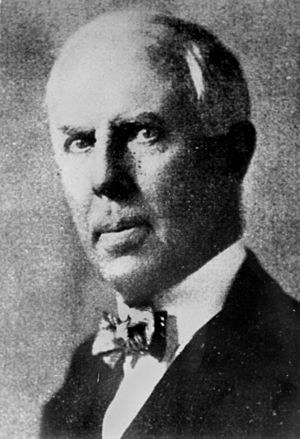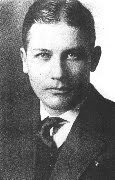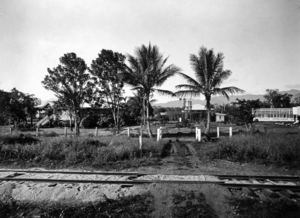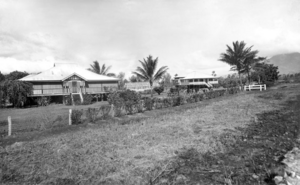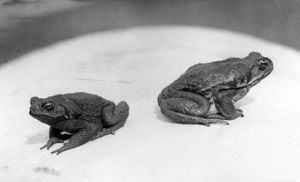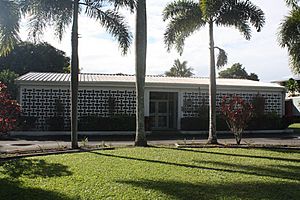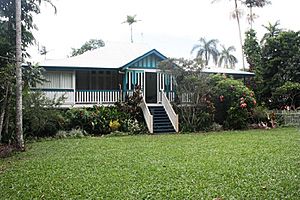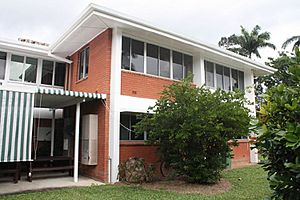Meringa Sugar Experiment Station facts for kids
Quick facts for kids Meringa Sugar Experiment Station |
|
|---|---|
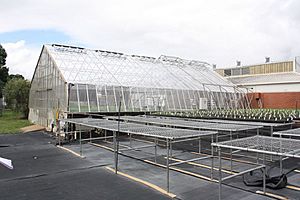
Meringa Sugar Experiment Station glasshouses, 2013
|
|
| Location | 71378 Bruce Highway, Meringa, Gordonvale, Cairns Region, Queensland, Australia |
| Built | 1917,1935,1957,1962,1969 |
| Architect | Goodsir & Carlyle, Baker & Wilde, Queensland Department of Public Works |
| Official name: Meringa Sugar Experiment Station | |
| Type | state heritage |
| Designated | 18 July 2014 |
| Reference no. | 602835 |
| Type | Education, research, scientific facility: Experimental station/farm |
| Theme | Exploiting, utilising and transforming the land: Agricultural activities; Exploiting, utilising and transforming the land: Experimenting, developing technologies and innovation |
| Builders | Queensland Department of Public Works |
| Lua error in Module:Location_map at line 420: attempt to index field 'wikibase' (a nil value). | |
The Meringa Sugar Experiment Station is a special research centre in Queensland, Australia. It's located near Gordonvale on the Bruce Highway. This station has been a very important part of Queensland's sugar industry since 1917.
It started by researching insect pests that harmed sugar cane. Later, it became a key place for breeding new and better types of sugarcane. Today, it is run by Sugar Research Australia.
Contents
A Brief History of Sugar in Queensland
The land where the Meringa Sugar Experiment Station now stands was once home to the Yidiny people. European settlers arrived in the area in the late 1870s. The town of Gordonvale, originally called Nelson, grew because of the sugar industry.
The Mulgrave Central Sugar Mill opened in 1896. This mill was part of a new system where many small farms grew sugar cane, and a central mill processed it. Before this, large plantations with their own mills were common.
Sugar became very important for Queensland's economy. The government supported the industry, helping it grow and become more modern.
Researching Sugar Cane
By the early 1900s, people realised that research was vital for the sugar industry. The first Sugar Experiment Stations (SES) in the world were set up in other countries. Queensland's first SES opened in Mackay in 1900.
The Bureau of Sugar Experiment Stations (BSES) was created in 1900 to help farmers and millers. They researched how to grow, harvest, and process sugar cane better.
Fighting Pests: The Entomological Station
In 1911, scientists began studying insects that harmed sugar cane. An American scientist named Alexandre Arsène Girault started this work in Gordonvale. The biggest problem insect was the greyback grub. These grubs ate the roots of the sugar cane, causing a lot of damage.
To study these grubs better, the Meringa site was chosen in 1916. It became the Entomological Station in 1917. Two houses, a laboratory, and an insectary were built there. Scientists tried different ways to stop the grubs, like using chemicals in the soil.
Breeding Better Sugar Cane
In the 1930s, Meringa started focusing on breeding new types of sugar cane. This work was moved from another station to Meringa in 1934. Scientists wanted to create cane varieties that were stronger, grew better, and resisted diseases.
To help with this, more land was added to the station. New buildings were also constructed, including a large glasshouse and a shed for farm equipment. Meringa became the main centre for sugar cane breeding in Queensland. Today, almost all the sugar cane grown in Queensland comes from varieties first developed at Meringa.
The Cane Toad Experiment
In 1935, a special enclosure was built at Meringa for cane toads. About 100 toads were brought from Hawaii. The idea was that these toads would eat the cane beetles that damaged the sugar cane.
However, some people warned that the toads might cause problems. After being bred at Meringa, 2400 toads were released in August 1935. Despite warnings, more toads were released later. This led to a big ecological problem, as the toads spread widely and harmed native animals, but they did not control the cane beetles.
Controlling Grubs with Insecticide
In the 1940s, scientists at Meringa began testing a new insecticide called benzene hexachloride (BHC). This chemical was very successful at controlling the greyback grubs. Farmers were allowed to use it from 1947, which greatly helped the sugar industry.
However, later on, people became worried about BHC harming the environment and human health. Because of these concerns, its use in farming ended in Australia in the 1980s.
Modern Research at Meringa
Over the years, the Meringa Sugar Experiment Station continued to grow and add new facilities. New office and laboratory buildings were constructed in the 1960s to support more staff and research.
Modern facilities like the crossing facility (1977–1980) and photoperiod houses (1986–2008) were built. Photoperiod houses allow scientists to control light and darkness to make sugar cane flower at specific times. This helps them breed new varieties more efficiently.
In 2013, the BSES became part of a new organisation called Sugar Research Australia (SRA). The Meringa SES is still the main place for breeding new sugar cane varieties for the entire Australian sugar industry. Many important scientists have worked here, helping to improve sugar cane farming.
What You Can See Today
The Meringa Sugar Experiment Station covers a large area of land. The main research buildings are set among trees and lawns.
Office and Laboratory (1962)
This building is one storey tall and made of red bricks. It has offices in the front and a laboratory at the back, connected by a covered walkway. The laboratory still has its original layout and equipment, like benches and sinks.
Entomologist's Residence (1917)
This is an old, one-storey timber house. It has a central part surrounded by a wide veranda. A kitchen wing is attached at the back. This house shows what the station looked like when it first started as a place to study insects.
Office (1969)
This two-storey brick building is connected to the 1962 office by a covered walkway. It has workshops, a photography darkroom, and a lecture room on the ground floor. The first floor has offices, a laboratory, and a library.
The Glasshouse (1957)
This building is made of steel and glass. It is used to grow plants in a controlled environment. It has special vents and louvres to help with air circulation.
The Implement and Tractor Shed (1935)
This shed is made of timber and covered with corrugated metal. It was used to store farm equipment and tractors. It also had stables for horses and rooms for storing fertiliser.
Photoperiod Facility (1986–2008)
These are three large steel structures. Inside, they have special chambers where scientists can control the light and dark. This helps them make sugar cane flower at specific times for breeding.
Crossing Facility (1977–1980)
This facility has two open-sided steel structures. Inside, there are frames that support special lanterns used in the process of "cane crossing," which is how new sugar cane varieties are bred.
Why Meringa Sugar Experiment Station is Important
The Meringa Sugar Experiment Station is important for several reasons:
- It shows how Queensland's sugar industry has grown and changed since 1917.
- It was the first and only station dedicated to studying insect pests in sugar cane.
- It has been a key site for important scientific work, including breeding new sugar cane types and testing ways to control pests.
- It has a long history with the Bureau of Sugar Experiment Stations (BSES), which has played a huge role in developing the sugar industry in Queensland and Australia. Today, it continues this work as part of Sugar Research Australia.


